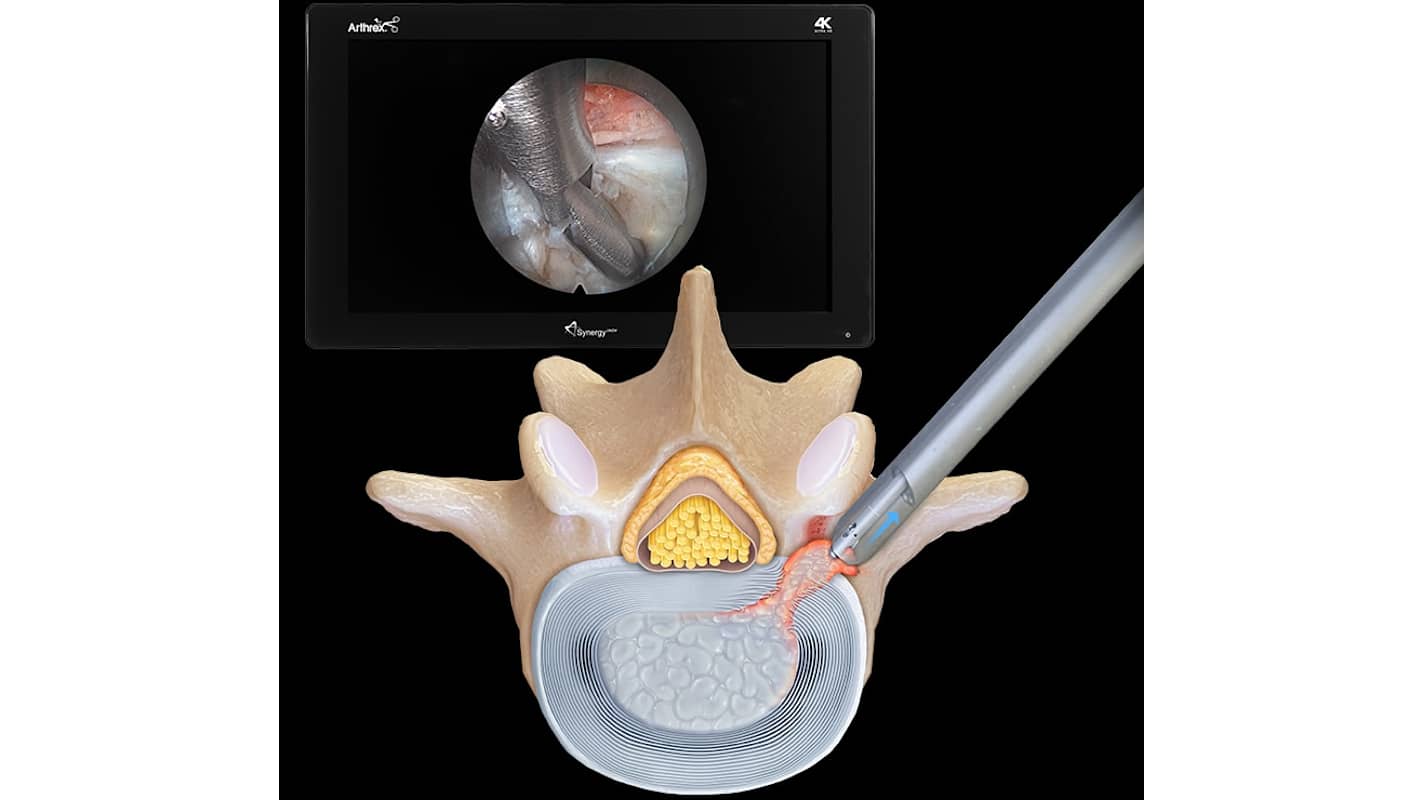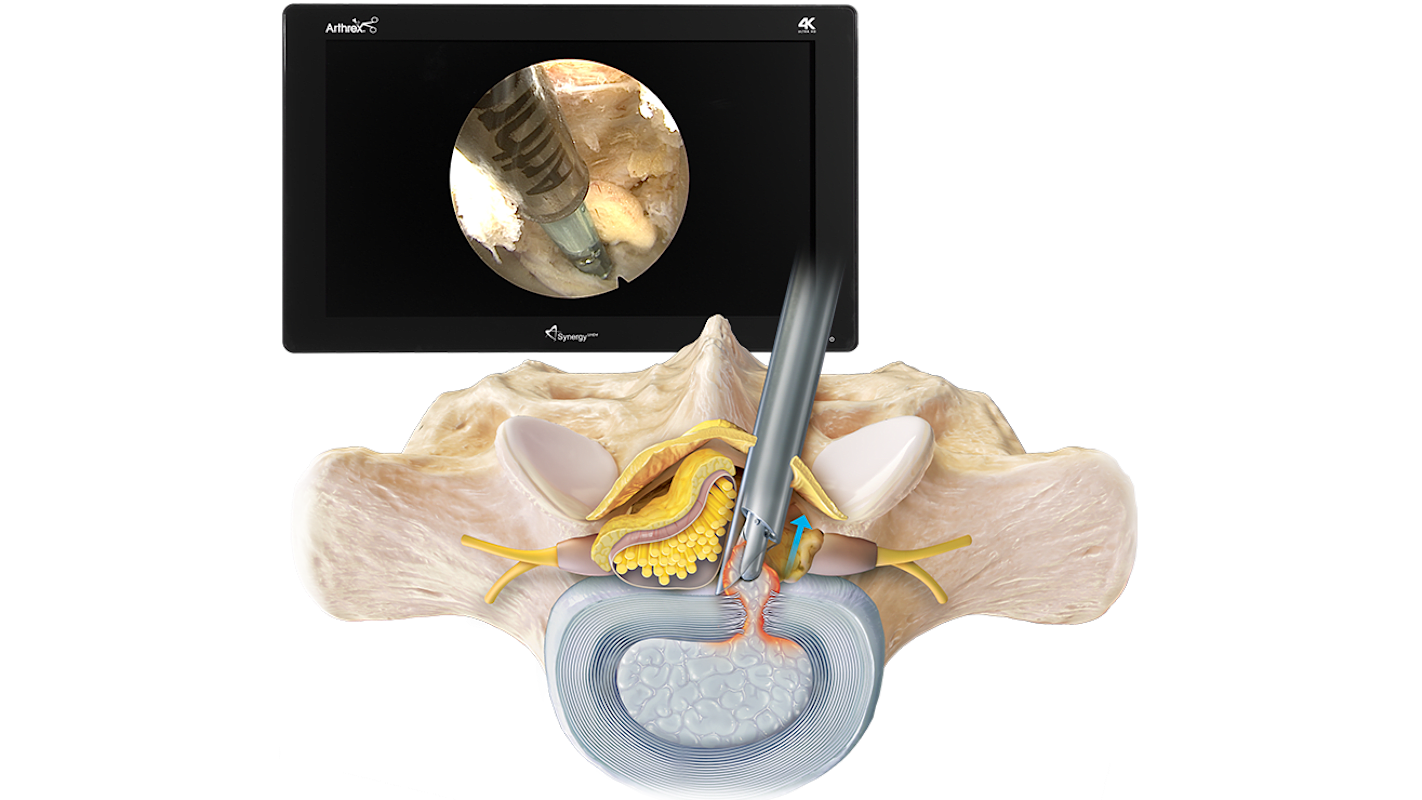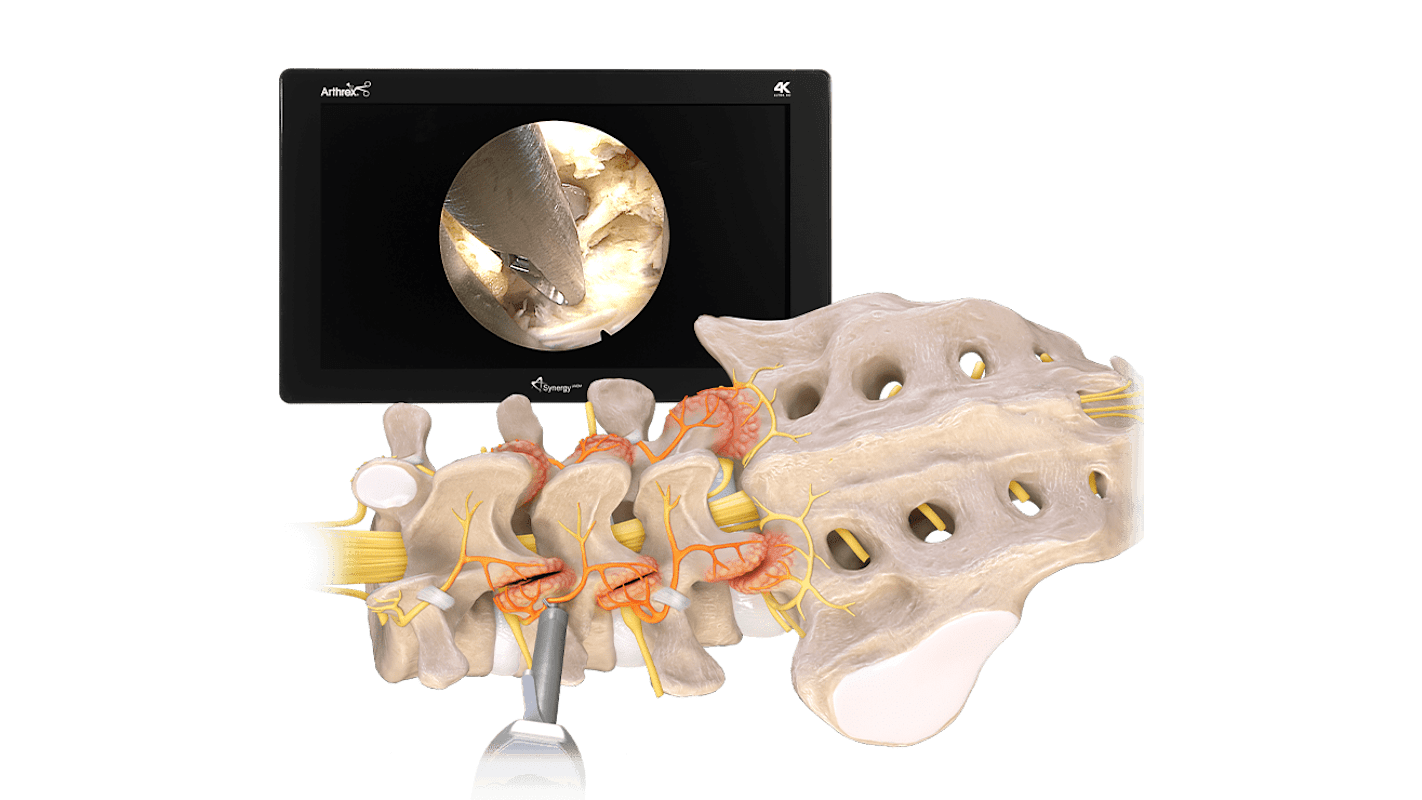

Spine
Transforaminal Endoscopic Discectomy
A transforaminal, or paraspinal, approach provides the ability to reach far-lateral disc herniations. Using a spine-specific endoscope minimizes soft-tissue disruption, resulting in less postoperative pain.1,2 Additionally, studies showed that approximately 85% patients who underwent endoscopic lumbar discectomy returned to athletic activity in as few as 6 to 8 weeks.3,4
References
1. Sairyo K, Matsuura T, Higashino K, et al. Percutaneous endoscopic lumbar discectomy for athletes. J Spine. 2013;S5(006):1-4. doi:10.4172/2165-7939.S5-006
2. Sivakanthan S, Williams JR, Feroze AH, et al. Endoscopic spine surgery in athletes: case series and review of literature. World Neurosurg. 2021;145:702-707. doi:10.1016/j.wneu.2020.08.211
3. Polikandriotis JA, Hudak EM, Perry MW. Minimally invasive surgery through endoscopic laminotomy and foraminotomy for the treatment of lumbar spinal stenosis. J Orthop. 2013;10(1):13-16. doi:10.1016/j.jor.2013.01.006
4. Ruetten S, Komp M, Merk H, Godolias G. Use of newly developed instruments and endoscopes: Full-endoscopic resection of lumbar disc herniations via the interlaminar and lateral transforaminal approach. J Neurosurg Spine. 2007;6(6):521-530. doi:10.3171/spi.2007.6.6.2


Spine
Interlaminar Endoscopic Discectomy
The endoscopic approach to interlaminar discectomies provides minimally invasive access to posterior herniations in the lower lumbar spine that may be difficult to reach through a transforaminal approach. Additionally, interlaminar discectomy results in less tissue and muscle disruption, faster recovery times, and a quicker return to activity than traditional open procedures.1-4 WishBone™ endoscopic instruments feature superior feel and improved ergonomics that facilitate inverted and retrograde usage with either hand.
References
1. Matsumoto M, Hasegawa T, Ito M, et al. Incidence of complications associated with spinal endoscopic surgery: nationwide survey in 2007 by the Committee on Spinal Endoscopic Surgical Skill Qualification of Japanese Orthopaedic Association. Orthop Sci. 2010;15(1):92-96. doi:10.1007/s00776-009-1428-6
2. Ahn Y, Oh HK, Kim H, Lee SH, Lee HN. Percutaneous endoscopic lumbar foraminotomy: an advanced surgical technique and clinical outcomes. Neurosurgery. 2014;75(2):124-133. doi:10.1227/NEU.0000000000000361
3. Polikandriotis JA, Hudak EM, Perry MW. Minimally invasive surgery through endoscopic laminotomy and foraminotomy for the treatment of lumbar spinal stenosis. J Orthop. 2013;10(1):13-16. doi:10.1016/j.jor.2013.01.006
4. Ruetten S, Komp M, Merk H, Godolias G. Use of newly developed instruments and endoscopes: Full-endoscopic resection of lumbar disc herniations via the interlaminar and lateral transforaminal approach. J Neurosurg Spine 2007;6(6):521-530. doi:10.3171/spi.2007.6.6.2.


Spine
Arthrex Graft Gun
The graft gun can be used to deliver even the most challenging bone grafts, such as fibers, chips, and autograft chunks. This device can be used for interbody fusions requiring bone graft both pre- and postimplantation, and a cartridge loading system allows for quick assembly and loading on the back table.
Learn More

Spine
Cervical Foraminotomy and Decompression
Minimally invasive endoscopic cervical foraminotomy and decompression is designed to treat cervical radiculopathy and other conditions that compress the nerve root. Utilizing an endoscope, surgeons can directly visualize and remove compressive pathology such as disc herniations, osteophytes, and hypertrophic ligaments. This technique minimizes soft-tissue disruption, reduces blood loss, allows for quicker recovery, and has demonstrated high clinical success rates, with a systematic review reporting 91.3% overall and up to 94.2% for posterior approaches.1,2 Additionally, long-term follow-ups show lasting symptom relief, high patient satisfaction, and a lower risk of adjacent segment disease compared to traditional ACDF surgery.3
Potential applications include treatment of cervical radiculopathy, herniated cervical discs, cervical spondylosis, foraminal stenosis, and osteophytes (bone spurs). Research supports its effectiveness in treating both soft disc herniations, where the nucleus pulposus compresses the nerve root, and hard disc herniations caused by calcified disc material.4 A lower incidence of spinal instability has also been reported, suggesting a reduced need for future spinal fusion procedures.5
Careful patient selection is key to optimal surgical outcomes; those with major deformity, instability, or large central herniations may require alternative surgery. With proper selection and advancing technology, this method remains a safe, effective, and motion-preserving option for cervical nerve decompression.1
References
1. Huang CC, Fitts J, Huie D, Bhowmick DA, Abd-El-Barr MM. Evolution of cervical endoscopic spine surgery: current progress and future directions—a narrative review. J Clin Med. 2024;13(7):2122. doi:10.3390/jcm13072122
2. Alomar SA, Maghrabi Y, Baeesa SS, Alves ÓL. Outcome of anterior and posterior endoscopic procedures for cervical radiculopathy due to degenerative disk disease: a systematic review and meta-analysis. Global Spine J. 2022;12(7):1546-1560. doi:10.1177/2192568221103727
3. Kim HS, Wu PH, Tze-Chun Lau E, Jang IT. Narrative review of uniportal posterior endoscopic cervical foraminotomy. World Neurosurg. 2024;181:148-153. doi:10.1016/j.wneu.2023.10.021
4. Bergamaschi JPM, Brito MBS, Araújo FF, et al. Surgical technique of central and over-the-top full-endoscopic decompression of the cervical spine: a technical note. J Pers Med. 2023;13(10):1508. doi:10.3390/jpm13101508
5. Zhang C, Wu J, Zheng W, Li C, Zhou Y. Posterior endoscopic cervical decompression: review and technical note. Neurospine. 2020;17(Suppl 1):S74-S80. doi:10.14245/ns.2040166.083


Spine
Medial Branch Transection
An endoscopic approach to medial branch nerve transection can lead to relief from pain caused by facet joint arthropathy. Combining 4K visualization with minimally invasive techniques allows surgeons to view and treat the spinal pathology while maintaining surgical precision and reducing postoperative complications.1,2
References
1. Lewandrowski KU, Ransom NA, Yeung A. Return to work and recovery time analysis after outpatient endoscopic lumbar transforaminal decompression surgery. J Spine Surg. 2020 Jan;6(Suppl 1):S100-S115. doi:10.21037/jss.2019.10.01
2. Sivakanthan S, Williams JR, Feroze AH, et al. Endoscopic spine surgery in athletes: case series and review of literature. World Neurosurg. 2021;145:702-707. doi:10.1016/j.wneu.2020.08.211
Disclaimers
infoYou might be trying to access information for a product that is not cleared for sale in the selected country.
infoVisit Contact Us for additional assistance.
Disclaimers
infoYou might be trying to access information for a product that is not cleared for sale in the selected country.
infoVisit Contact Us for additional assistance.
What's New in Spine
Join us for a Hands-On Experience
If you're searching for a venue that can offer a fully immersive educational experience, your quest is over. Welcome to Arthrex University and Innovation Hotel.
eventView Educational Opportunities